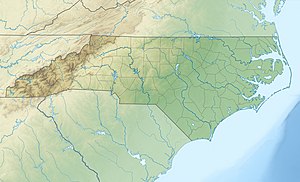| Stinking Creek Tributary to Haw River | |
|---|---|
  | |
| Location | |
| Country | United States |
| State | North Carolina |
| County | Chatham |
| Physical characteristics | |
| Source | divide between Stinking Creek and Roberson Creek |
| • location | about 4 miles southeast of Pittsboro, North Carolina |
| • coordinates | 35°40′46″N 079°08′07″W / 35.67944°N 79.13528°W / 35.67944; -79.13528 |
| • elevation | 480 ft (150 m) |
| Mouth | Haw River |
| • location | B. Everett Jordan Lake |
| • coordinates | 35°41′00″N 079°04′46″W / 35.68333°N 79.07944°W / 35.68333; -79.07944 |
| • elevation | 217 ft (66 m) |
| Length | 4.41 mi (7.10 km) |
| Basin size | 6.49 square miles (16.8 km) |
| Discharge | |
| • location | Haw River |
| • average | 7.91 cu ft/s (0.224 m/s) at mouth with Haw River |
| Basin features | |
| Progression | Haw River → Cape Fear River → Atlantic Ocean |
| River system | Haw River |
| Tributaries | |
| • left | unnamed tributaries |
| • right | unnamed tributaries |
| Bridges | Moncure Pittsboro Road (x2), Gum Springs Church Road |
Stinking Creek is a 4.41 mi (7.10 km) long 2nd order tributary to the Haw River in Chatham County, North Carolina.
Course
Stinking Creek rises about 4 miles southeast of Pittsboro, North Carolina in Chatham County and then flows in a semi-circle to the Haw River at B. Everett Jordan Lake. Stinking Creek makes up one of the arms of the lake.
Watershed
Stinking Creek drains 6.49 square miles (16.8 km) of area, receives about 47.5 in/year of precipitation, and has a wetness index of 383.56 and is about 79% forested.
See also
References
- ^ "GNIS Detail - Stinking Creek". geonames.usgs.gov. US Geological Survey. Retrieved 28 September 2019.
- ^ "Stinking Creek Topo Map, Chatham County NC (Merry Oaks Area)". TopoZone. Locality, LLC. Retrieved 28 September 2019.
- "ArcGIS Web Application". epa.maps.arcgis.com. US EPA. Retrieved 28 September 2019.
- ^ "Stinking Creek Watershed Report". Waters Geoviewer. US EPA. Retrieved 28 September 2019.
Additional images

